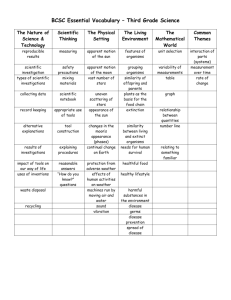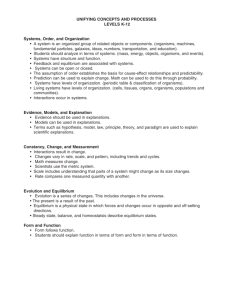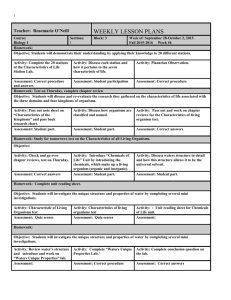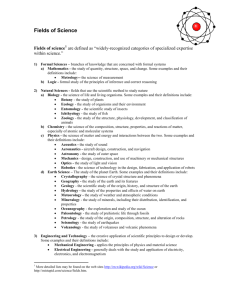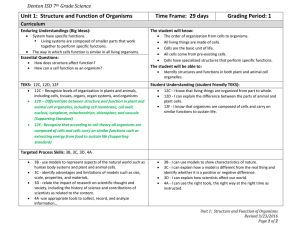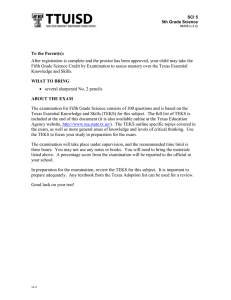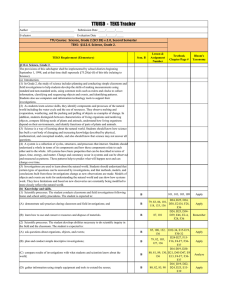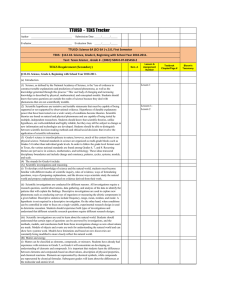8th Grade Science STAAR Quick Reference Guide
advertisement
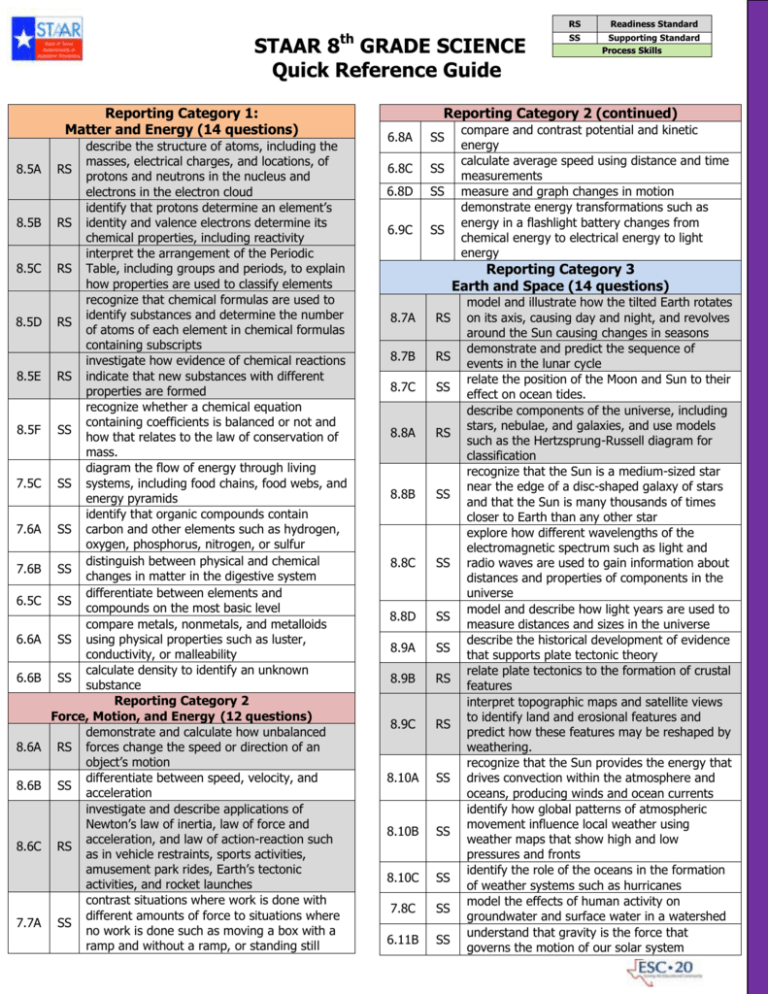
th STAAR 8 GRADE SCIENCE Quick Reference Guide Reporting Category 1: Matter and Energy (14 questions) 8.5A 8.5B 8.5C 8.5D 8.5E 8.5F 7.5C 7.6A 7.6B 6.5C 6.6A 6.6B 8.6A 8.6B 8.6C 7.7A describe the structure of atoms, including the masses, electrical charges, and locations, of RS protons and neutrons in the nucleus and electrons in the electron cloud identify that protons determine an element’s RS identity and valence electrons determine its chemical properties, including reactivity interpret the arrangement of the Periodic RS Table, including groups and periods, to explain how properties are used to classify elements recognize that chemical formulas are used to identify substances and determine the number RS of atoms of each element in chemical formulas containing subscripts investigate how evidence of chemical reactions RS indicate that new substances with different properties are formed recognize whether a chemical equation containing coefficients is balanced or not and SS how that relates to the law of conservation of mass. diagram the flow of energy through living SS systems, including food chains, food webs, and energy pyramids identify that organic compounds contain SS carbon and other elements such as hydrogen, oxygen, phosphorus, nitrogen, or sulfur distinguish between physical and chemical SS changes in matter in the digestive system differentiate between elements and SS compounds on the most basic level compare metals, nonmetals, and metalloids SS using physical properties such as luster, conductivity, or malleability calculate density to identify an unknown SS substance Reporting Category 2 Force, Motion, and Energy (12 questions) demonstrate and calculate how unbalanced RS forces change the speed or direction of an object’s motion differentiate between speed, velocity, and SS acceleration investigate and describe applications of Newton’s law of inertia, law of force and acceleration, and law of action-reaction such RS as in vehicle restraints, sports activities, amusement park rides, Earth’s tectonic activities, and rocket launches contrast situations where work is done with different amounts of force to situations where SS no work is done such as moving a box with a ramp and without a ramp, or standing still RS Readiness Standard SS Supporting Standard Process Skills Reporting Category 2 (continued) 6.8A SS 6.8C SS 6.8D SS 6.9C SS compare and contrast potential and kinetic energy calculate average speed using distance and time measurements measure and graph changes in motion demonstrate energy transformations such as energy in a flashlight battery changes from chemical energy to electrical energy to light energy Reporting Category 3 Earth and Space (14 questions) 8.7A RS 8.7B RS 8.7C SS 8.8A RS 8.8B SS 8.8C SS 8.8D SS 8.9A SS 8.9B RS 8.9C RS 8.10A SS 8.10B SS 8.10C SS 7.8C SS 6.11B SS model and illustrate how the tilted Earth rotates on its axis, causing day and night, and revolves around the Sun causing changes in seasons demonstrate and predict the sequence of events in the lunar cycle relate the position of the Moon and Sun to their effect on ocean tides. describe components of the universe, including stars, nebulae, and galaxies, and use models such as the Hertzsprung-Russell diagram for classification recognize that the Sun is a medium-sized star near the edge of a disc-shaped galaxy of stars and that the Sun is many thousands of times closer to Earth than any other star explore how different wavelengths of the electromagnetic spectrum such as light and radio waves are used to gain information about distances and properties of components in the universe model and describe how light years are used to measure distances and sizes in the universe describe the historical development of evidence that supports plate tectonic theory relate plate tectonics to the formation of crustal features interpret topographic maps and satellite views to identify land and erosional features and predict how these features may be reshaped by weathering. recognize that the Sun provides the energy that drives convection within the atmosphere and oceans, producing winds and ocean currents identify how global patterns of atmospheric movement influence local weather using weather maps that show high and low pressures and fronts identify the role of the oceans in the formation of weather systems such as hurricanes model the effects of human activity on groundwater and surface water in a watershed understand that gravity is the force that governs the motion of our solar system Reporting Category 4: Organisms and Environments (14 questions) 8.11A RS 8.11B RS 8.11C 8.11D 7.10B 7.10C 7.11A 7.11C 7.12B 7.12D RS SS SS SS SS SS SS SS 7.12F SS 7.14B SS 7.14C SS 6.12D SS describe producer/consumer, predator/prey, and parasite/host relationships as they occur in food webs within marine, freshwater, and terrestrial ecosystems investigate how organisms and populations in an ecosystem depend on and may compete for biotic and abiotic factors such as quantity of light, water, range of temperatures, or soil composition explore how short-and long-term environmental changes affect organisms and traits in subsequent populations recognize human dependence on ocean systems and explain how human activities such as runoff, artificial reefs, or use of resources have modified these systems describe how biodiversity contributes to the sustainability of an ecosystem observe, record, and describe the role of ecological succession such as in a microhabitat of a garden with weeds. examine organisms or their structures such as insects or leaves and use dichotomous keys for identification identify some changes in genetic traits that have occurred over several generations through natural selection and selective breeding such as the Galapagos Medium Ground Finch (Geospiza fortis) or domestic animals identify the main functions of the systems of the human organism, including the circulatory, respiratory, skeletal, muscular, digestive, excretory, reproductive, integumentary, nervous, and endocrine systems differentiate between structure and function in plant and animal cell organelles, including cell membrane, cell wall, nucleus, cytoplasm, mitochondrion, chloroplast, and vacuole recognize that according to cell theory all organisms are composed of cells and cells carry on similar functions such as extracting energy from food to sustain life compare the results of uniform or diverse offspring from sexual reproduction or asexual reproduction recognize that inherited traits of individuals are governed in the genetic material found in the genes within chromosomes in the nucleus identify the basic characteristics of organisms, including prokaryotic or eukaryotic, unicellular or multicellular, autotrophic or heterotrophic, and mode of reproduction, that further classify them in the currently recognized Kingdoms Process Skills Embedded in at least 40% of the questions 8.1A 8.1B 8.2A 8.2B 8.2C 8.2D 8.2E 8.3A 8.3B 8.3C 8.3D 8.4A 8.4B demonstrate safe practices during laboratory and field investigations as outlined in the Texas Safety Standards practice appropriate use and conservation of resources, including disposal, reuse, or recycling of materials plan and implement comparative and descriptive investigations by making observations, asking welldefined questions, and using appropriate equipment and technology design and implement comparative and experimental investigations by making observations, asking welldefined questions, formulating testable hypotheses, and using appropriate equipment and technology collect and record data using the International System of Units (SI) and qualitative means such as labeled drawings, writing, and graphic organizers construct tables and graphs, using repeated trials and means, to organize data and identify patterns analyze data to formulate reasonable explanations, communicate valid conclusions supported by the data, and predict trends in all fields of science, analyze, evaluate, and critique scientific explanations by using empirical evidence, logical reasoning, and experimental and observational testing, including examining all sides of scientific evidence of those scientific explanations, so as to encourage critical thinking by the student use models to represent aspects of the natural world such as an atom, a molecule, space, or a geologic feature identify advantages and limitations of models such as size, scale, properties, and materials relate the impact of research on scientific thought and society, including the history of science and contributions of scientists as related to the content use appropriate tools to collect, record, and analyze information, including lab journals/notebooks, beakers, meter sticks, graduated cylinders, anemometers, psychrometers, hot plates, test tubes, spring scales, balances, microscopes, thermometers, calculators, computers, spectroscopes, timing devices, and other equipment as needed to teach the curriculum use preventative safety equipment, including chemical splash goggles, aprons, and gloves, and be prepared to use emergency safety equipment, including an eye/face wash, a fire blanket, and a fire extinguisher Number of Standards Readiness Standards Supporting Standards Number of Questions 15 60 – 65% 32 – 35 34 35 – 40% 19 – 22 50 Multiple Choice and 4 Griddable

